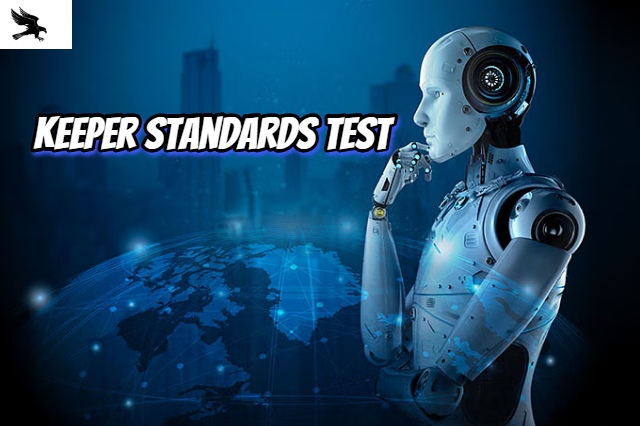With artificial intelligence rapidly changing industries and shaping the pattern of our lives, there is where the creation of AI systems should be researched and implemented in a very ethical manner, considering this technology has the capacity of deciding matters that will meet people, especially issues pertaining to health care and finance. One such framework is the Keeper Standards Test, which is a full test solution that tests whether there is ethical compliance, transparency, and reliability in AI technology. We now talk about the key features, how it works, and why it is a must-have for organizations engaged with responsible AI practices in the following article.
What is the Keeper Standards Test?
The Keeper Standards Test is a testing framework designed in the form of a test to ensure overall quality, ethical compliance, and transparency in AI systems. It ensures that the technologies employed by organizations are aligned with the major ethical principles of fairness, accountability, and reliability. This is significant because more and more applications of AI systems occur in critical areas, including health, finance, criminal justice, and education, where the impact of the outcome on people’s lives and communities is massive. The Keeper Standards Test rates AI systems against multiple dimensions of bias detection, ethical alignment, transparency, and performance reliability. This test is one of the ways through which organizations could find potential risks, remove bias, and make sure that the AI models are responsibly used and in a way worthy of trust.
Keeper Standards Test Key Features of Features in Key Keeper Standards Test
Key Keeper Standards Test offers an integrated and holistic evaluation of AI systems. A few significant features that ensure such technologies to be fair, trustworthy, and ethical are ;
1. Bias Detection and Mitigation
Probably one of the most important challenges in AI development is bias. This can come from data that the AI systems are trained on or the algorithms themselves, which leads to discrimination. The Keeper Standards Test possesses advanced tools to detect and eliminate bias at multiple stages of AI development. Pre-processing tools help detect and eliminate bias in the training data before building a model. In-processing tools monitor and adjust the model during the training phase to avoid biased patterns. Post-processing tools analyze the AI’s outputs and adjust for any biases in the predictions. These tools help organizations reduce bias and ensure that AI models make fair and equitable decisions for all user groups.
2. Ethical Compliance
Ethical concerns in AI are more than just the avoidance of bias. The standards test of the Keeper AI checks whether an AI system maintains important ethical principles in fairness, accountability, and transparency. This criterion ensures that these AI systems are unbiased; they respect user privacy and are transparent and accountable for their decisions. Organizations avoid harmful impacts of society by making AI models ethically sound, contributing to responsible technology usage. Ethical compliance is also important because it makes sure that organizations are compliant with other legal and regulatory compliance, such as GDPR and non-discrimination laws.
3. Transparency and Accountability
Transparency is the backbone of ethical AI development. The Keeper Standards Test requires that organizations provide clear documentation on how their AI models work, including what data are used and how the model is trained, so the decisions are known. This will let the users as well as the stakeholders get a feel for what goes around inside the AI system, resulting in the acceptance of the AI technology with relatively easier trust levels. Responsibility is also met within the testing phase to account for interactions involving the AI system. It becomes possible for such organizations to track and thus provide reasoning as to any decisions reached through an AI-based system that enables accountability with error or biases. This transparency only fuels confidence and allows organisations to remain compliant and avoid risk legally.
4. Credibility and Performance
It should be trustworthy to matter the situation it would ever be used. It shall therefore be tested, including its performance and dependability using the Keeper Standards Test, while ensuring at every time that the AI yields correct outputs and remains reliable. The evaluation criteria include the robustness of systems so that the AI indeed is robust enough to take in many inputs and work correctly under all conditions. It also assesses consistency in performance to ensure that the AI system indeed provides accurate results both in the short term and long term, and under all forms of operating environments. Another evaluation technique is scalability, which tells us whether the AI system is working fine as it scales or even when it gets deployed in different scenarios. These tests will establish the usefulness and reliability of AI systems, especially in real applications.
Importance of Keeper Standards Test
The Keeper Standards Test is a must-have aspect of responsible development and deployment of AI systems. Here’s why the framework is important for organizations now:
1. Meeting Regulatory Compliance
As AI technologies advance, governments and regulatory bodies introduce new laws and guidelines that ensure the development and use of AI systems responsibly. The Keeper Standards Test ensures adherence to the regulations which state that AI systems must satisfy specific ethical standards and align within legal frameworks such as Data Protection Regulation (such as GDPR) and against a non-discrimination approach. An organization will ensure reduced legal risk and assure loyalty to the implementation of standards required by an industry by simply passing the test.
2. Building Trust with Users
Perhaps one of the biggest hurdles to adoption is trust. Users are going to be more likely to trust AI systems that are transparent, ethical, and reliable. Passing the Keeper AI Standards Test by an organization will tell users and stakeholders that it has the commitment to building responsible AI systems that value fairness and transparency. Such trust is a key to achieving wide-scale acceptance and usage of AI technologies.
3. Fairness and Nonharm
These AI systems can perform high-stakes decisions. Their repercussions are going to be directly placed in people’s lives; few examples include decisions on access healthcare, loan approvals, or hiring/terminating someone on the job. Considering their impact on society, with such impacts on society at play, these decisions will need to come fairly without biasness. Hence, the risk of doing harm through discriminatory practice is reduced by the Keeper Standards Test. This procedure will help identify and eliminate biases, maintain compliance with ethics, and keep transparency while giving a test to reduce risks for harmful results.
4. Improving System Reliability and Efficiency
Functional AI systems work with high reliability and accuracy. Whether deployed in a healthcare scenario or applied in customer services, AI must function at an optimal level. Keeper Standards Test provides an evaluation that helps the organization establish if their AI systems will reliably perform by giving results of accuracy, staying stable for different conditions, and growing when the system expands. Such helps in enhancing effectiveness levels of an AI model that ensures satisfaction for a user.
How to Apply the Keeper Standards Test
Usually, the organizations that intend to apply the Keeper Standards Test do so by undergoing a systematic process of assessment. The process entails pre-assessment, identifying key ethical and performance metrics that the organizations wish to evaluate about their AI systems. Data collection then ensues whereby all the necessary data, documents, and model details are acquired for evaluation. Subsequently, the testing phase includes the AI system running through the Keeper Standards Test, which is tests for bias, transparency, performance, and ethical compliance. The results are then given to the organization with recommendations for change by the evaluation. Such assessments over time will enable the maintenance of high standards both on ethics and performance by responsible evolution of AI systems.
Conclusion
The Keeper Standards Test is an important resource to ensure that the AI systems within organizations are ethical, transparent, and reliable. This is because the standards tested in terms of bias detection, ethical compliance, transparency, and performance help organisations develop AI technologies that will be fair, accountable, and trustworthy. This means that it is a very important framework of the Keeper Standards Test of responsible AI development because it caters to growing needs in many industries regarding transparency, fairness, and reliability through AI systems. Focused organizations shall have better prospects to ensure that there will be a possibility of generating trust, compliance, and lower risk of damaging the consequences for the AI deployment.

